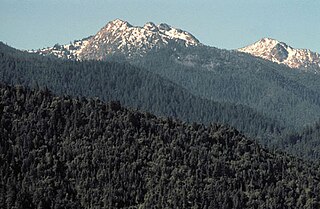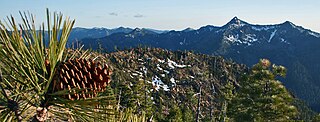
The Klamath Mountains are a rugged and lightly populated mountain range in northwestern California and southwestern Oregon in the western United States. As a mountain system within both the greater Pacific Coast Ranges and the California Coast Ranges, the Klamath Mountains have a varied geology, with substantial areas of serpentinite and marble, and a climate characterized by moderately cold winters with very heavy snowfall and warm, very dry summers with limited rainfall, especially in the south. As a consequence of the geology and soil types, the mountains harbor several endemic or near-endemic trees, forming one of the largest collections of conifers in the world. The mountains are also home to a diverse array of fish and animal species, including black bears, large cats, owls, eagles, and several species of Pacific salmon. Millions of acres in the mountains are managed by the United States Forest Service. The northernmost and largest sub-range of the Klamath Mountains are the Siskiyou Mountains.

The Siskiyou Mountains are a coastal subrange of the Klamath Mountains, and located in northwestern California and southwestern Oregon in the United States. They extend in an arc for approximately 100 miles (160 km) from east of Crescent City, California, northeast along the north side of the Klamath River into Josephine and Jackson counties in Oregon. The mountain range forms a barrier between the watersheds of the Klamath River to the south and the Rogue River to the north. Accordingly, much of the range is within the Rogue River – Siskiyou and Klamath national forests, and the Pacific Crest Trail follows a portion of the crest of the Siskiyous.

The caddisflies, or order Trichoptera, are a group of insects with aquatic larvae and terrestrial adults. There are approximately 14,500 described species, most of which can be divided into the suborders Integripalpia and Annulipalpia on the basis of the adult mouthparts. Integripalpian larvae construct a portable casing to protect themselves as they move around looking for food, while Annulipalpian larvae make themselves a fixed retreat in which they remain, waiting for food to come to them. The affinities of the small third suborder Spicipalpia are unclear, and molecular analysis suggests it may not be monophyletic. Also called sedge-flies or rail-flies, the adults are small moth-like insects with two pairs of hairy membranous wings. They are closely related to the Lepidoptera which have scales on their wings; the two orders together form the superorder Amphiesmenoptera.

Cupressus bakeri, reclassified as Hesperocyparis bakeri, with the common names Baker cypress, Modoc cypress, or Siskiyou cypress, is a rare species of cypress tree endemic to a small area across far northern California and extreme southwestern Oregon, in the western United States.

The Cascade–Siskiyou National Monument is a United States national monument that protects 114,000 acres (46,134 ha) of forest and grasslands at the junction of the Cascade Range and the Siskiyou Mountains in Southwestern Oregon and Northwestern California, United States. The monument is managed by the Bureau of Land Management as part of the National Landscape Conservation System. It was established in a presidential proclamation by President Bill Clinton on June 9, 2000 and expanded by President Barack Obama on January 12, 2017.

Limnephilidae is a family of caddisflies with about 100 genera. They belong to the main lineage of case-constructing caddisflies, the Integripalpia or tube-case caddisflies. The Limnephilidae is one of the most species-rich Trichoptera families of northern temperate regions, but only a few are known from tropical areas and the Southern Hemisphere. For this reason they are often known as northern caddisflies.

The Red Buttes Wilderness is a wilderness area in the Klamath and Rogue River national forests in the U.S. states of Oregon and California. It comprises 19,940 acres (8,070 ha), approximately 16,190 acres (6,550 ha) of which is located in California, and 3,750 acres (1,520 ha) in Oregon. It was established by the California Wilderness Act of 1984 and the Oregon Wilderness Act of 1984.

The Siskiyou Wilderness is a federal wilderness area designated by the passage of the California Wilderness Act of 1984. Originally, the land area was 153,000 acres (620 km2) The Northern California Wild Heritage Act of 2006 added 30,122 acres (121.90 km2) for the current total of 182,802 acres (739.77 km2). All of the wilderness is in Northern California and is managed by the U.S. Forest Service. The wilderness spans three national forests: the Rogue River–Siskiyou, the Klamath, and the Six Rivers.

Iris bracteata, with common name is Siskiyou iris, is a species of iris.
The Siskiyou chipmunk is a species of rodent in the family Sciuridae. It is endemic to northern California and central Oregon in the United States.
Erigeron cervinus is a North American species of flowering plant in the family Asteraceae known by the common names Siskiyou fleabane and Siskiyou daisy.

Fritillaria glauca is a species of fritillary known by the common names Siskiyou fritillary and Siskiyou missionbells.

The Klamath Mountains ecoregion of Oregon and California lies inland and north of the Coast Range ecoregion, extending from the Umpqua River in the north to the Sacramento Valley in the south. It encompasses the highly dissected ridges, foothills, and valleys of the Klamath and Siskiyou Mountains. It corresponds to the Level III ecoregion designated by the Environmental Protection Agency and to the Klamath-Siskiyou forests ecoregion designated by the World Wide Fund for Nature.

Allium siskiyouense is a North American species of wild onion known by the common name Siskiyou onion. It is native to the Klamath Mountains and nearby ranges of northern California and Oregon. It grows in serpentine and other rocky soil types.

Phlox hirsuta, the Yreka phlox or hairy phlox, is a species of phlox. It is a small flowering plant that grows in the serpentine soils of Siskiyou County, California and is the official city flower of Yreka, California, after which it is named.
Chilostigma itascae, also known as the headwaters chilostigman, is a species of caddisfly in the family Limnephilidae. It was discovered in mile-long Nicollet Creek, the Mississippi River's headwaters in Itasca State Park, Minnesota, which remained the only known location for the species for 31 years. However, in 2005 and 2011 it was found in other locations in and around Itasca State Park and in 2017 an effort to study winter caddisflies by the Minnesota Biological Survey found it in peatland locations scattered across the northwestern part of the state and there are unconfirmed photo records from across the Canadian border in Thunder Bay District, Ontario. It was discovered by Glenn Wiggins, a scientist from the Royal Ontario Museum, on New Year's Eve of 1974, and was scientifically described by him in the following year. Unlike other caddisflies, its adult emergence occurs in the winter under the cover of deep snow.

Prosartes, the fairybells, is a North American genus of flowering plants in the lily family.

Limnephilus is a genus of caddisflies in the family Limnephilidae. There are over 180 species of Limnephilus, described between 1824 and 1999.

Ironoquia plattensis, the Platte River caddisfly, is a species of caddisfly in the family Limnephilidae. It is endemic to Nebraska. This species was first described to science in 2000.

Chimarra is a genus of little black caddisflies in the family Philopotamidae. There are more than 630 described species in Chimarra.
















